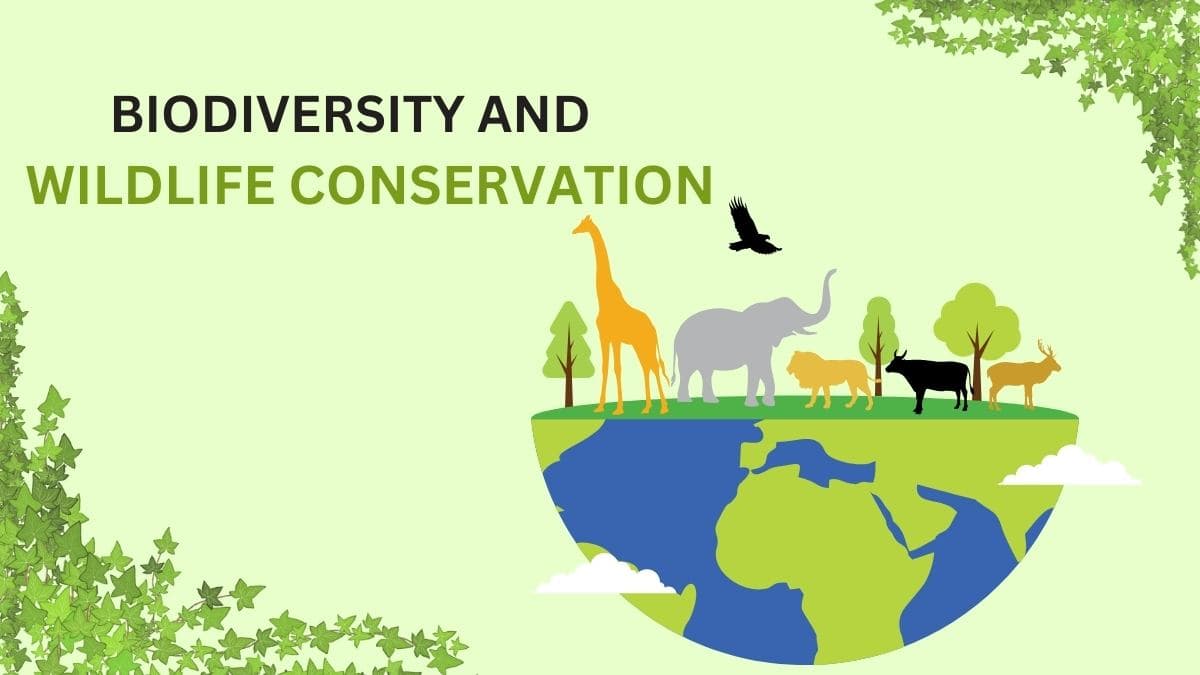What is Biodiversity and Wildlife Conservation for Kids?
By Pinkey Sharma |
Date 30-08-2024

Table of Contents
Admissions Open for
Have you ever looked around and seen all the different kinds of plants and animals that live on our planet? From bright-colored butterflies up to soaring trees; from small insects up to giant whales—the variety of life on Earth is just so huge. In this blog post, we will discuss details about what is Biodiversity, Biodiversity for kids, why conservation of Biodiversity is so crucial, and how everyone can help protect it.
What is Biodiversity?
Biodiversity measures the amplitude of life forms found in an area. It takes into account the different species of plants, animals, and micro-organisms together with all the diverse ecosystems that are formed. Biodiversity can be visualized as a jigsaw puzzle: a huge one. Every different kind of species or habitat is a piece of this puzzle. When put in their respective places, they form a whole picture of life on Earth.
Why is Biodiversity Important for Kids?
“Biodiversity for Kids” is a big word, but that is not why kids should care about biodiversity. Here are some reasons why:
Healthy Ecosystems Support Life: Biodiversity operates to keep healthiness and balance among ecosystems like forests, oceans, and wetlands. Healthful ecosystems are important to us because they give us clean air, water, and food. For instance, forests give off oxygen into the atmosphere and filter water, and coral reefs provide homes to most sea creatures.
Education: Learners acquire much enjoyment and knowledge from learning about different species and their functions in nature. The children will learn how the different plants and animals relate to one another to maintain a stable environment. This education will enable the kids to appreciate and understand the natural environment that surrounds them.
Biodiversity: With biodiversity, marvelous creatures and plants just fuel curiosity and wonder. The vibrant colors of a peacock's tail or the considerable height of a redwood tree are only some of the marvels in nature that could spark a child's imagination and foster a love for science and the environment.
Loss of Biodiversity
Unfortunately, this biodiversity is under major threat through the activities of humans. Here's how we're losing it and why it's a problem.
Habitats are destroyed: Whenever forests have been cleared to grow crops or build homes,cities, animals and plants are being deprived of their previous homes.Therefore, without a habitat, much displacement of species is likely to occur. For example, deforestation of the Amazon rainforest has let go of quite a good number of plant and animal species lost by mankind.
Pollution: This involves factory and automobile pollution, which may cause the contamination of air, water, and soil. The flora and fauna are harmed and cannot thrive well in their development. An example of this is plastic garbage in the oceans, which swallows aquatic animals and injures.
Climate Change: Changes in climate, including rising temperatures and shifting weather patterns, upset habitats and affect the survivability of species. Some animals and plants may not have the ability to adapt quickly enough to these changes. For instance, polar bears are in trouble because the Arctic ice where they hunt seals is melting.
Overexploitation: Very high rates of fishing, hunting, and collection of plants and animals reduce populations to such low levels that extinction could result. For example, overfishing of certain fish disrupts the balance in marine ecosystems.
Why is Biodiversity Crucial for Ecosystem Health?
Balance and Stability: Each species has a different role in its environment. In greater detail, predators are there to place bounds on population sizes of other animals, whereas plants produce oxygen and food for others. Because of that, a more diverse ecosystem is more resistant to deviation. The better state of balance refuses to run away with concerns occurring in scenarios like overpopulation of a single species or the collapse of an ecosystem.
Ecosystem Services: Biodiversity provides services important for life support. For example, bees and other insects help in pollinating plants necessary for the production of fruits and vegetables. Wetlands filter pollutants out of water, and forests regulate climate by capturing carbon dioxide. These services are important for human well-being and the health of the planet.
Medical and Scientific Research: Most medicines and scientific inventions are derived from plants, animals, and microbes. For example, the antibiotic penicillin was derived from a mold; most cancer treatments are derived from plant compounds. A large variety of species could provide new treatments and scientific knowledge that will benefit human health.
Endangered Species and Efforts to Protect Wildlife Habitats
Many species are at risk today due to the devastation of their habitats, pollution, and other perils. The following are what is undertaken to safeguard them and conserve their habitats:
Creating protected areas: National parks, sanctuaries, and marine protected areas are created to preserve the important habitats so that the endangered species can find a safe haven to live and prosper. In this regard, the Yellowstone National Park in America provides protection to a range of species such as bison and wolves.
Conservation Programs: Programs of organizations and governments to monitor and protect endangered species.These programs might involve breeding programs, habitat restoration, attempts to battle poaching, and illegal trade. An example of this is the World Wildlife Fund and its efforts to protect species such as tigers and rhinos.
Education and Awareness: Where there are people who are aware about the endangered species and the reasons to conserve, then they appreciate and understand that species need to be taken care of. Schools, museums, and media are the organizations, which give information about wildlife and how it is to be preserved. Education inculcates responsibility in people as well as a sense of responsibility.
How does biodiversity impact children?
Although biodiversity is scientific in nature, its impacts on children are both multifaceted and profound. Understanding the aspects in which biodiversity impacts children may justify why children need to be protected.
Let's look deeper into the influences that biodiversity has on children's lives:
1. Health and well-being:
Rich biodiversity in plants, animals, and micro-organisms has numerous contributions to providing a healthy surrounding.
Cleaner Air and Water: Ecosystems such as forests and wetlands generally maintain the cleanliness and quality of air and water. Children can play and grow up in these areas. For example, forests absorb carbon dioxide and release oxygen, playing a crucial role in human respiration health.
Mental Health Benefits: Some researches have revealed that exposure to natural landscapes with abundant wildlife is established to reduce stress and increase mental well-being. Nature often has a calming effect that could allow children to relax their minds and focus. When children hike through a forest or go to a park, it can enhance their mood and promote cognitive function
2.The Trails for Education Opportunities:
There are several learning experiences that can be designed for the kids using biodiversity
Ecosystem Learning: The activities make children learn simple principles of ecology in an exploratory way about various species and their relation with others. This can be by studying how bees transfer the pollen of the flowers, making the children appreciate the role of insects in making food as well as balancing the ecosystem.
Scientific Inquisitiveness: A rich diversity of nature gives rise to curiosity, and the curiosity leads to exploration. Children, by being exposed to kinds and types of species and several environments in learning, get interested in science, nature, and conservation. This, in turn, will lead to other interests such as biological interests, environmental sciences, and wildlife management.
3. Art and Storytelling:
The colors, patterns, behaviors of animals, and plants present an unlimited source of inspiration for children to draw pictures of some strange animals or to create an adventure story, maybe even designing their own fantasy creatures that look like them.
Essentially, the varied environment presented by biodiversity should be a playground for the children. From building forts in the woods to watching birds in the garden, nature interaction promotes creativity, which leads to pleasure.
4. Connectedness to Nature
Diversity nature makes the children more related to the natural environment:
Gaining an understanding of interconnectedness: It is through the study of the various species and ecosystems that the children come to realize the ways in which all forms of life are fundamentally inseparably connected. This knowledge will evoke responsibility and motivation toward care for the environment.
Environmental Stewardship: Through taking the perspective of appreciating biodiversity, children will cherish its concern. If a local cleanup process starts, they will be at the forefront of participating in the activity of nature protection. They can also be able to advocate for the protection of wildlife or other environmental frontage.
5. Physical Activity
Activities in a varied pattern of natural cycles influence physical exercise:
Environmental Awareness: The excitement of wildlife and vegetation in any area offers hiking, biking, and exploring natural areas that enhance these activities, making them very interesting and enjoyable. All these activities enhance physical health and follow up on making children remain in love with outdoor fun.
Gardening and Nature Projects: The act of planting native species in a garden can be a good learning process and a physically engaging activity for the child. This, very often, would get the kids to actually spend time outdoors and learn the working of the different species in their environment.
How can kids support wildlife and Conservation of Biodiversity?
Children can participate in conservation by maintaining the variety of life and protecting wildlife. These are some ways they can do it:
Know and Share: Educate yourself about different species and learn why biodiversity is so important. Share this knowledge with your family and friends when you get back home. You can read books or watch documentaries, or visit a variety of local wildlife centers.
Engage in clean-ups: Join or set up community-based cleanup activities aimed at keeping parks, beaches, and other natural sites free of litter and other pollution forms. Cleaning up trash helps protect wildlife and their habitats from being harmed.
Support Conservation Groups: Many organizations try to protect wildlife and their habitats. You could lend a hand by participating in their fundraisers, donating to their cause, or volunteering. For example, you can help to raise necessary funds for a conservation of biodiversity project or volunteer at a local animal shelter.
Adopt a Species: Some opportunities can allow a wildlife organization to "adopt" an endangered species. It is a way of raising funds to work on conservation and increase awareness of the particular species involved. In fact, adopting a species may even get you information about the sort of animal that it is and the region that it inhabits.
Create Habitats for Wildlife: You could help by creating an individual habitat in your backyard or a community garden. Indigenous plants help feed and water wildlife locally. Birdhouses and bee hotels can also be built to provide homes for different species.
The conservation of biodiversity is carried out:
1. To preserve and protect the species in their habitat.
2. To preserve the basic ecological course of action with the goal that there is no natural awkwardness made.
3. To use the species and environment supportably without misusing them.
4. To protect the blooming and fauna, common parks, safe-havens, biosphere turns around, etc. are set up.
5. To conserve genetic biodiversity by building up the zoological gardens, botanical gardens, nurseries, etc.
6. To ensure proper planning of land use and other natural resources so as to conserve biodiversity.
7. To prohibit the hunting, poaching of animals, fishing etc., beyond the productive capacity of the ecosystem.
8. To ensure biodiversity maintenance by enforcing the acts, laws of legislative controls such as India forests act, endangered species act, etc.,
9. To create public awareness about sustainable use of the species without affecting biodiversity.
10. To demarcate the specific regions as "reserved" so that no activity is allowed to take place in that zone. Example: reserve forests.
11. A variety of steps are now being undertaken worldwide towards the conservation of biodiversity pertaining to plants and animals.
Conclusion
A clear understanding of “What is biodiversity” and its importance helps a person appreciate Earth's varied and fascinating life. Involving children in the causes of Conservation of biodiversity and how to support wildlife, can make them save our future on this planet. Biodiversity is not just any word; it is part of our world that needs cherishing and safeguarding. Let all other human beings strive to this wonderful, diverse bounteous present that the good Earth has handed over to us. Take the path to learn more about your local wildlife or get engaged in local conservation to light up the fire of passion for nature in others.
Liked the above blog? Then, kindly share it with your friends to spread awareness on “What is Biodiversity?” and “Conservation of Biodiversity”
CBSE Schools In Popular Cities
- CBSE Schools in Bangalore
- CBSE Schools in Mumbai
- CBSE Schools in Pune
- CBSE Schools in Hyderabad
- CBSE Schools in Chennai
- CBSE Schools in Gurgaon
- CBSE Schools in Kolkata
- CBSE Schools in Indore
- CBSE Schools in Sonipat
- CBSE Schools in Delhi
- CBSE Schools in Rohtak
- CBSE Schools in Bhopal
- CBSE Schools in Aurangabad
- CBSE Schools in Jabalpur
- CBSE Schools in Jaipur
- CBSE Schools in Jodhpur
- CBSE Schools in Nagpur
- CBSE Schools in Ahmednagar
- CBSE School In Tumkur

Call Us to know more about Orchids
Swipe Up
















